Breaded, deep fried crispy pork cutlet is one of the top 10 favourite dishes among Japanese people. Quite easy to make and served with a sweet fruity sauce, it is so delicious. Tonkatsu is also the main ingredient in Katsu-don.
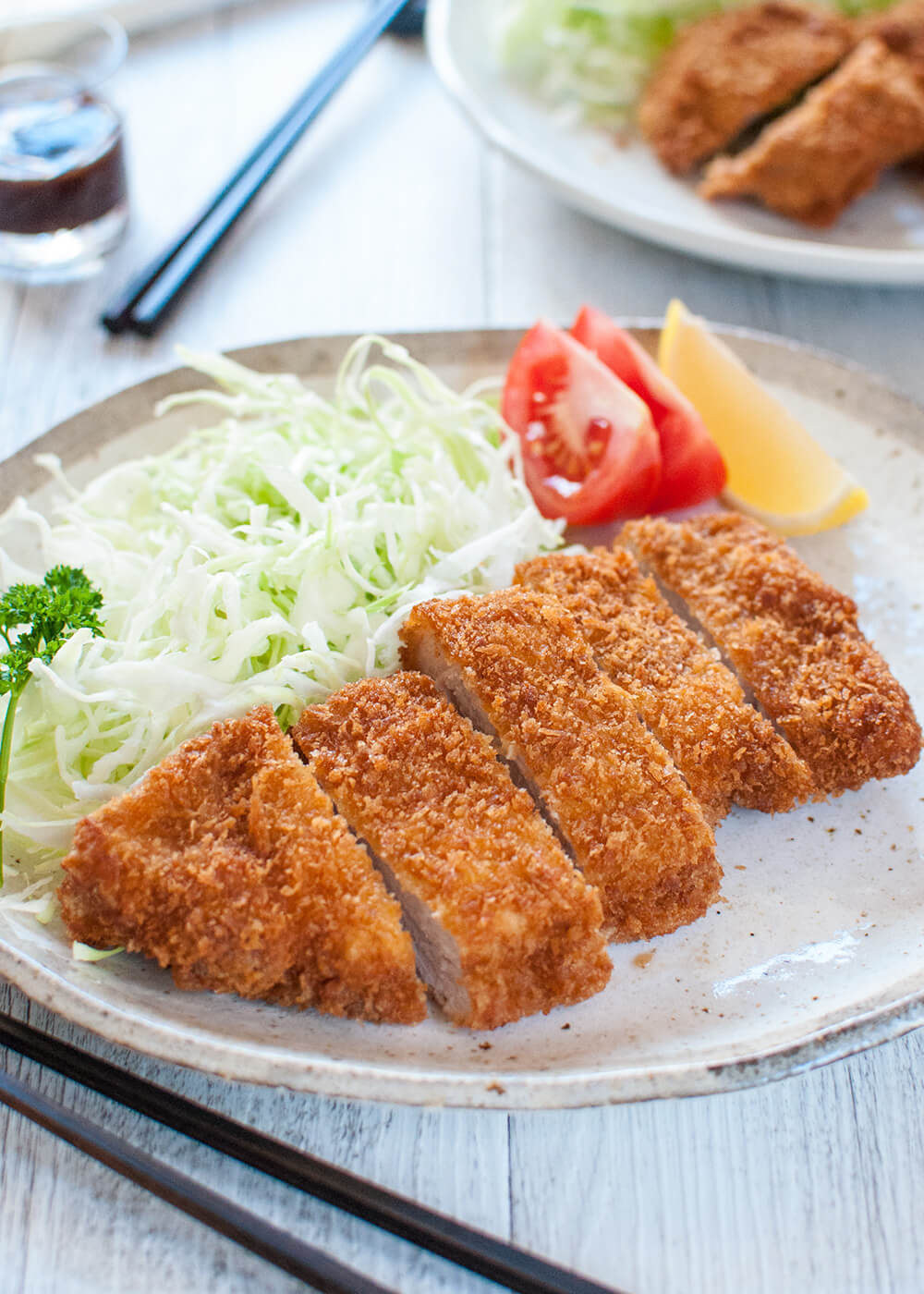
I already briefed you on how to make tonkatsu (Japanese fried pork cutlet) in the Katsu-don (Pork Cutlet and Egg on Rice) recipe. But I decided to post this as a separate recipe because there are a few things to be noted in making tonkatsu depending on the purpose and the type of meat used. And of course the way to serve tonkatsu is quite different from that of katsu-don.
Tonkatsu (豚カツ or とんかつ) was introduced at the end of the 19th century by a restaurant called Renga-tei (煉瓦亭) in Ginza, Tokyo. Prior to that, there was a dish called “katsuretsu” (カツレツ, derived from the word cutlet) that was equivalent to veal schnitzel at the time.
But Renga-tei used pork instead of beef/veal and the meat was deep fried. Japanese word for pork is “buta” (豚) and this kanji character can be pronounced as “ton”, hence tonkatsu (豚カツ) meaning pork cutlet.
When tonkatsu was first served at Renga-tei, it was accompanied by shredded cabbage. And even today, after more than 100 years, tonkatsu is always served with shredded cabbage in most restaurants and at home, including my tonkatsu. It just doesn’t look right without cabbage.
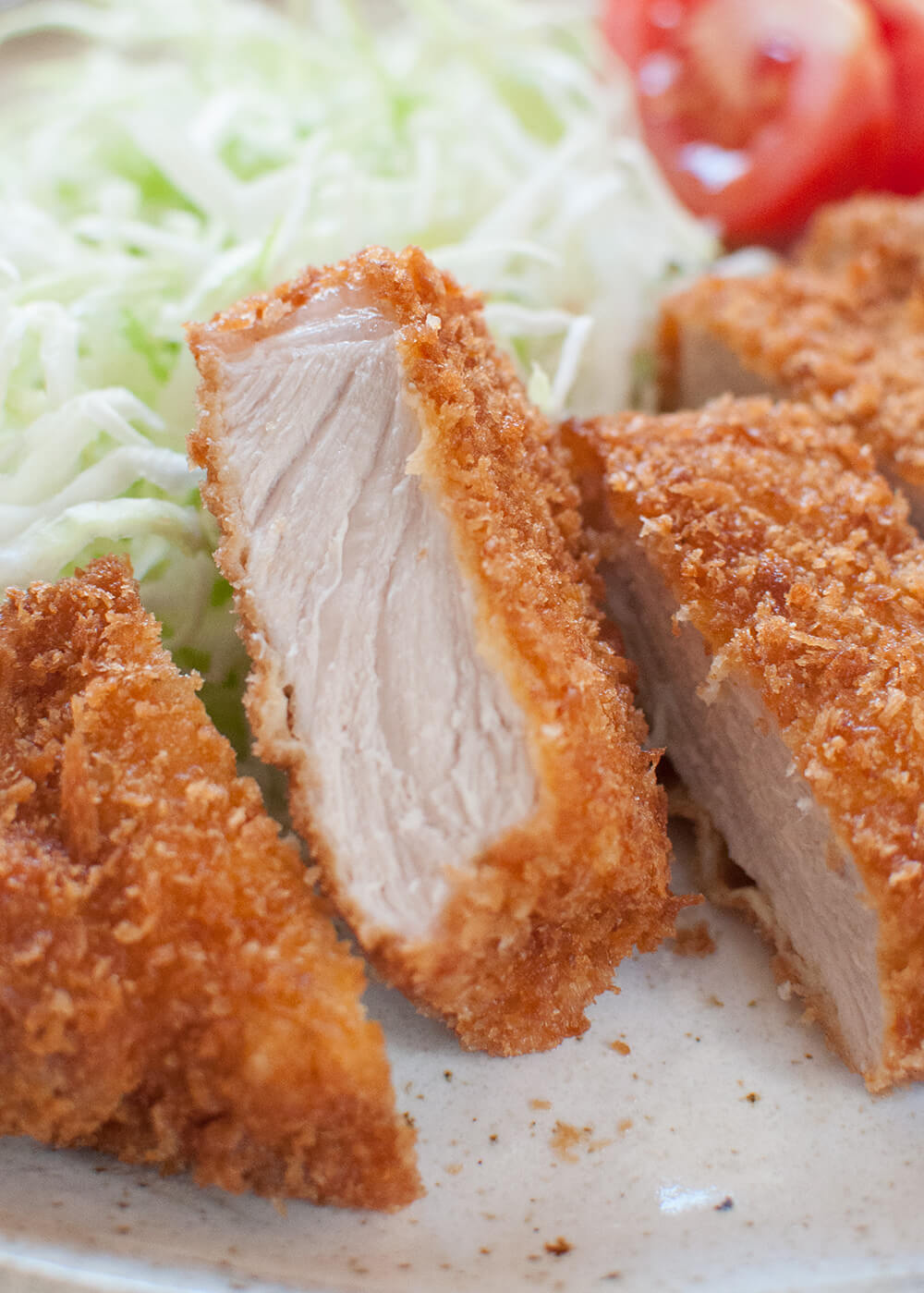
About Pork
The types of pork used for tonkatsu are usually either pork loin or pork tenderloin. When I had tonkatsu at restaurants in Japan a long time ago, they were pieces of pork loin that had a thick band of fat along one side of the meat. When deep fried, the fat became almost transparent and was very juicy. Being pretty young and active at the time, I thought the fat was the best part of the tonkatsu.
People are much more health conscious now and we tend to trim the fat off the meat as much as possible. But I think that small amount of fat should be retained if you use pork loin to make tonkatsu. This will compensate for the dryness of the flesh.
Pork tenderloin usually comes in a long log shape. It is possible to cut it into short logs and make tonkatsu out of it but I usually slice it to make small medallion tonkatsu. Japanese people call it “hitokuchi katsu” (一口カツ), meaning a bite-size cutlet, though the size is a bit larger than real bite-size.
Depending on the diameter of the tenderloin, I sometimes slice it 3cm (1¼“) wide diagonally to make it look larger. I do this so that after deep frying, I can cut it in half and each piece won’t look too small. See my tenderloin tonkatsu below.
Preparing Pork for Tonkatsu
If you are using pork tenderloin, all you need to do is to season the meat with salt and pepper before coating it with flour, egg and breadcrumbs. But in the case of pork loin, you will need to prepare the meat before seasoning.
Depending on how the loin is cut, it sometimes comes with the connecting tissue between the fat and meat or between different kinds of tissue. The connecting tissue is quite tough and it shrinks a lot when cooked, causing the tonkatsu to curl up.
By cutting the connecting tissue at 2-3cm (1”) intervals, you can prevent the meat from curling when fried. The top photo below shows where I cut the connecting tissue. The bottom photo is the tenderloin sliced diagonally.
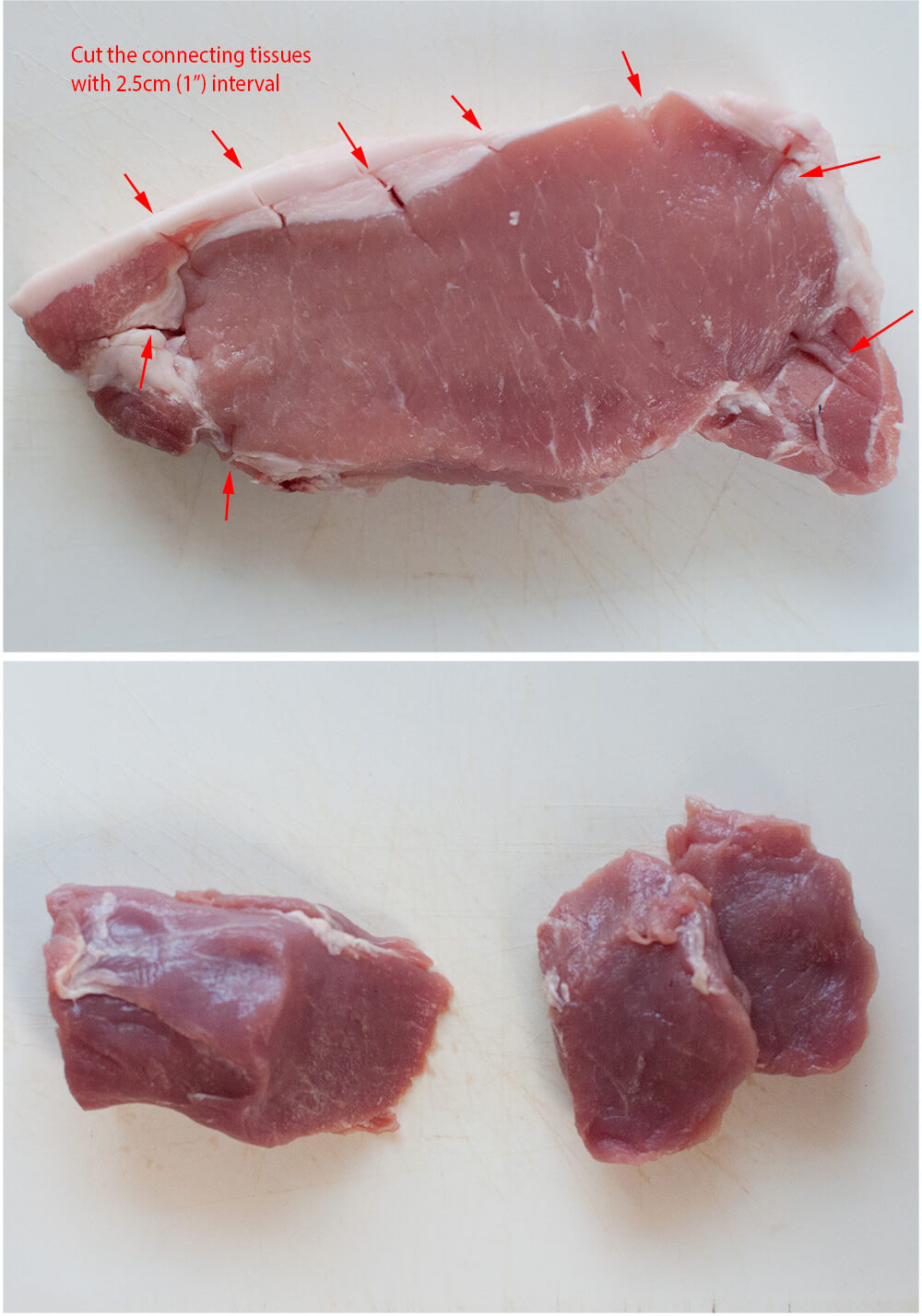
Tonkatsu Sauce
Tonkatsu must be served with sauce. I use Bulldog brand sauce, which I can buy at Asian/Japanese grocery stores. I talked about the Bulldog sauces in my recipe Yakisoba (Japanese Stir Fried Noodles), with photos of the different types of sauces. For tonkatsu, the thick fruity sauce called “tonkatsu so-su” (sauce for tonkatsu) would be the best, I think.
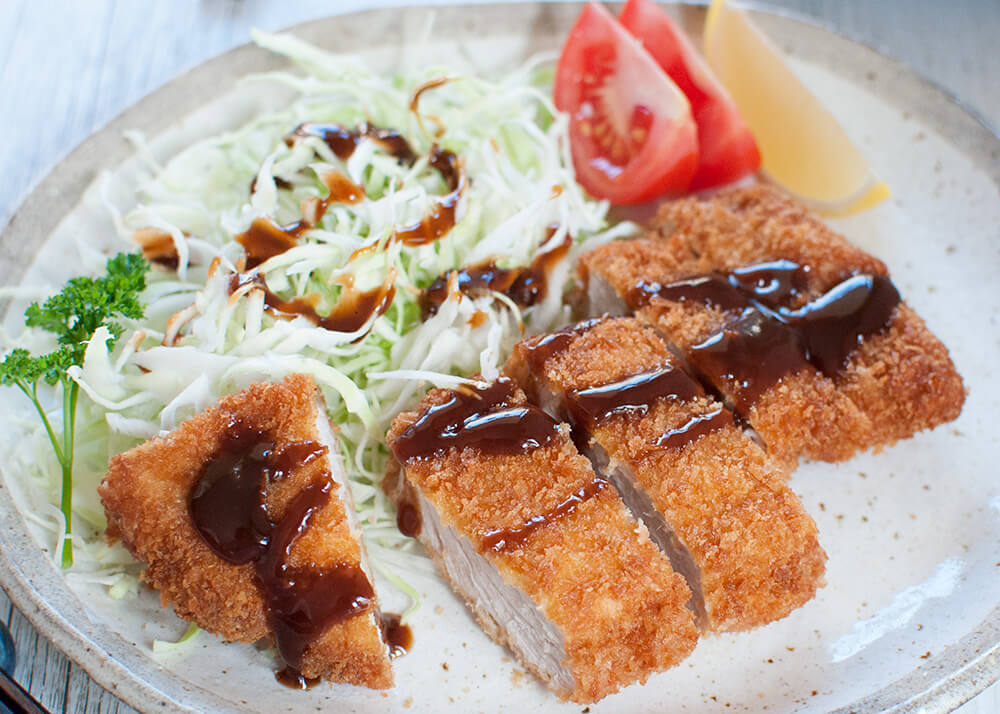
If you prefer spicier Worcestershire sauce, that’s OK too. But, with a few additional staple ingredients to the Worcestershire sauce, you can make a tonkatsu sauce similar to those you can buy at Asian/Japanese grocery stores or Amazon. I have included how to make tonkatsu sauce using Worcestershire sauce in the recipe.
Teishoku and Bento
Tonkatsu is a popular lunch dish in Japan. The restaurants in the office areas often offer set meals called “teishoku” (定食) which consists of a main dish, a side dish, pickles, rice and miso soup. If the main dish is tonkatsu, then the meal is called “tonkatsu teishoku”, if it’s pork shogayaki, then it becomes “shogayaki teishoku”.
Tonkatsu teishoku looks like the photo below. I added Chrysanthemum Leaves Goma-ae as a side, pickled Chinese cabbage, miso soup (freeze dried instant vegetable miso soup – please refer to my post, Instant Miso Soup) and rice.
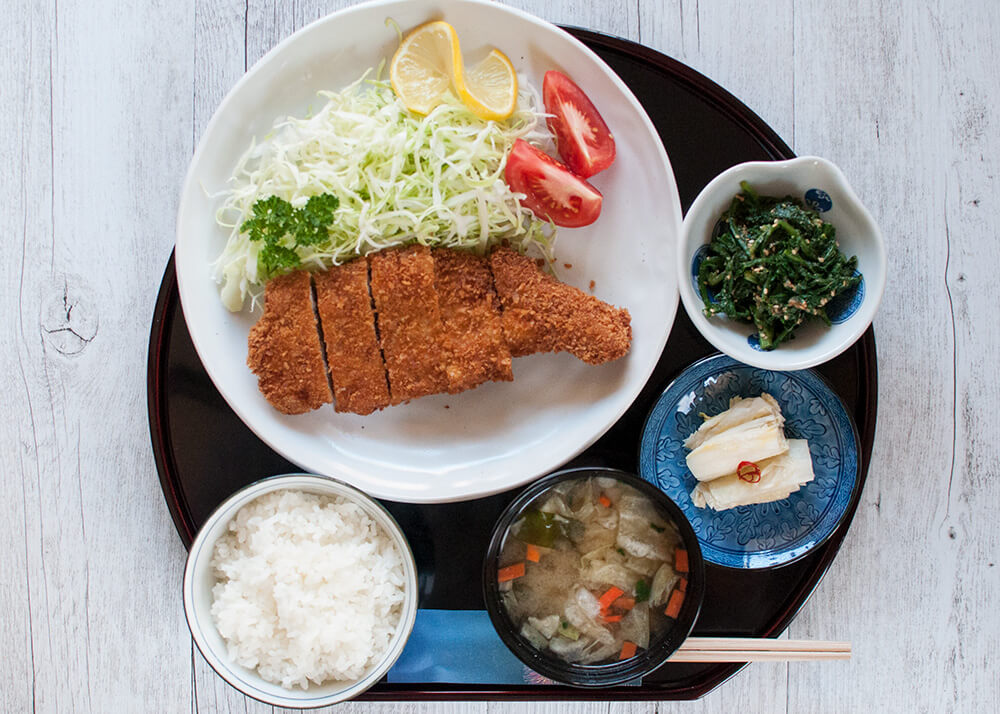
I also made a bento (弁当) box (lunch box) with tenderloin tonkatsu (photo below) to just show you what it looks like. Tonkatsu is delicious even if at room temperature, particularly with tenderloin as it is not fatty.
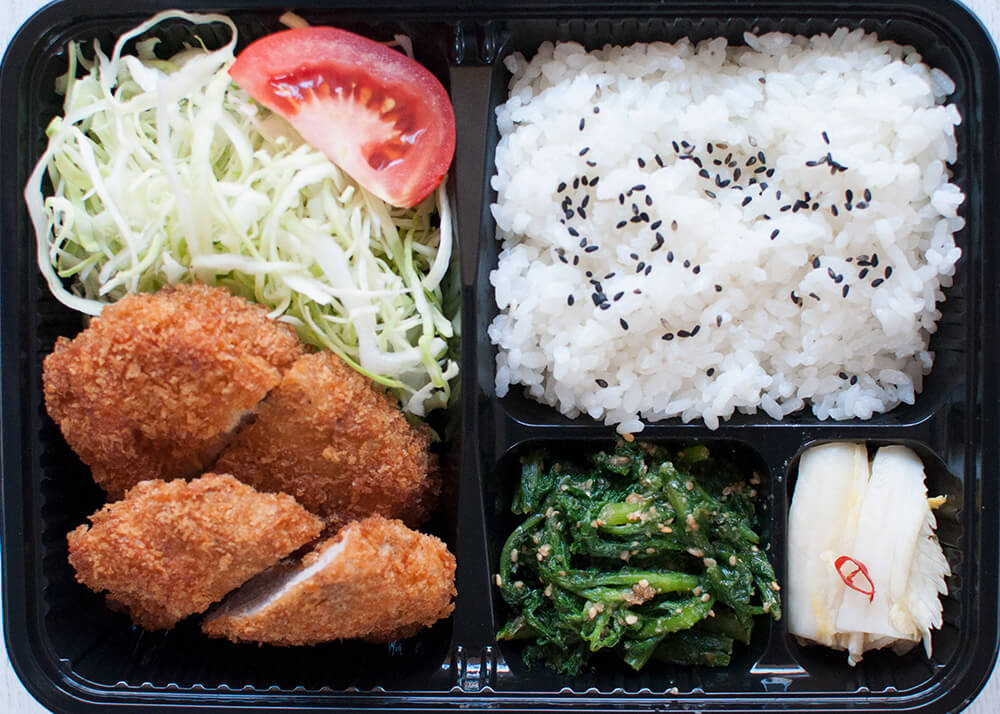 If I were to make tonkatsu for katsu-don, I would use slightly thinner slices of pork, about 1.5cm (⅝”) thick or a bit less, so that the tonkatsu would be covered enough in the sauce when cooked. Please visit my post Katsu-don (Pork Cutlet and Egg on Rice) for the katsu-don recipe.
If I were to make tonkatsu for katsu-don, I would use slightly thinner slices of pork, about 1.5cm (⅝”) thick or a bit less, so that the tonkatsu would be covered enough in the sauce when cooked. Please visit my post Katsu-don (Pork Cutlet and Egg on Rice) for the katsu-don recipe.
Why not make tonkatsu and serve it like tonkatsu teishoku?
Yumiko![]()

- 2 x 200g (3.9oz) pork loin about 2cm (¾") thick (note 1)
- Salt & pepper
- 1½ tbsp flour
- 1 egg beaten
- ⅔ cup panko breadcrumbs
- Oil for deep frying
- Shredded cabbage
- Sprigs of parsley
- Tomato wedges
- Lemon slices/wedges
- Bulldog tonkatsu sauce (note 4)
-
If there is connecting tissue separating red meat and a band of fat, cut the tissue every 2-3cm (1”). This will prevent the meat from curling when cooked. Lightly pound the pork to tenderise.
-
Sprinkle with salt and pepper on both sides of meat.
-
Coat the meat with flour, egg, then breadcrumbs.
-
Heat oil to 170C (338F) (note 2) and fry the meat for 2 minutes. Turnover and fry further 1.5 - 2 minutes (note 3) until it becomes golden brown.
-
Turn over again and fry for about 1 minute until deep golden brown, then put aside on kitchen paper.
-
Cut each tonkatsu into 2cm (¾") wide strips.
-
If you are making tonkatsu for katsu-don, go to Katsu-don instructions.
-
Serve with shredded cabbage and Bulldog tonkatsu sauce.
1. I bought a pork loin chop that came with bones and removed the bones. The bones went to Dozer.
You could also use pork tenderloin as an alternative. Pork tenderloin usually comes in a long log shape. It is possible to cut it into short logs and make tonkatsu out of it but I sometimes slice the log 3cm (1¼") wide diagonally and make small medallion tonkatsu (see the photos of tenderloin tonkatsu in the blog).
The thickness can vary and if you are making tonkatsu for Katsu-don, I would recommend thickness of about 1.5cm (⅝") or a bit less.
2. To check the temperature of the oil without a thermometer, use one of the following.
a. Drop small bits of breadcrumbs into the oil. The bits will sink half way and then come up with small bubbles around them.
b. Stick a pair of bamboo chopsticks into the oil. Small bubbles appear around the chopsticks and come up constantly.
3. If your meat is thicker or thinner, the time required to fry the meat will be longer/shorter respectively. If unsure, poke the tonkatsu with a skewer or a chopstick to see if clear juice comes out. Also, when the bubbles around the tonkatsu becomes smaller, it is usually cooked.
4. You can buy Bulldog Tonkatsu sauce at Japanese/Asian grocery stores or from Amazon. For more details on Japanese Bulldog sauces including sample photos, see my post, Yakisoba (Japanese Stir Fried Noodles).
If you don’t have store-bought tonkatsu sauce, you can make a similar sauce using Worcestershire sauce per below:
Mix 1½ tbsp Worcestershire sauce, 3 tbsp tomato sauce/ketchup, 1 tbsp soy sauce, ½ tsp sugar and 1½ tsp finely grated apple. Put the mixture through the sieve to remove the apple bits and make the sauce smooth.
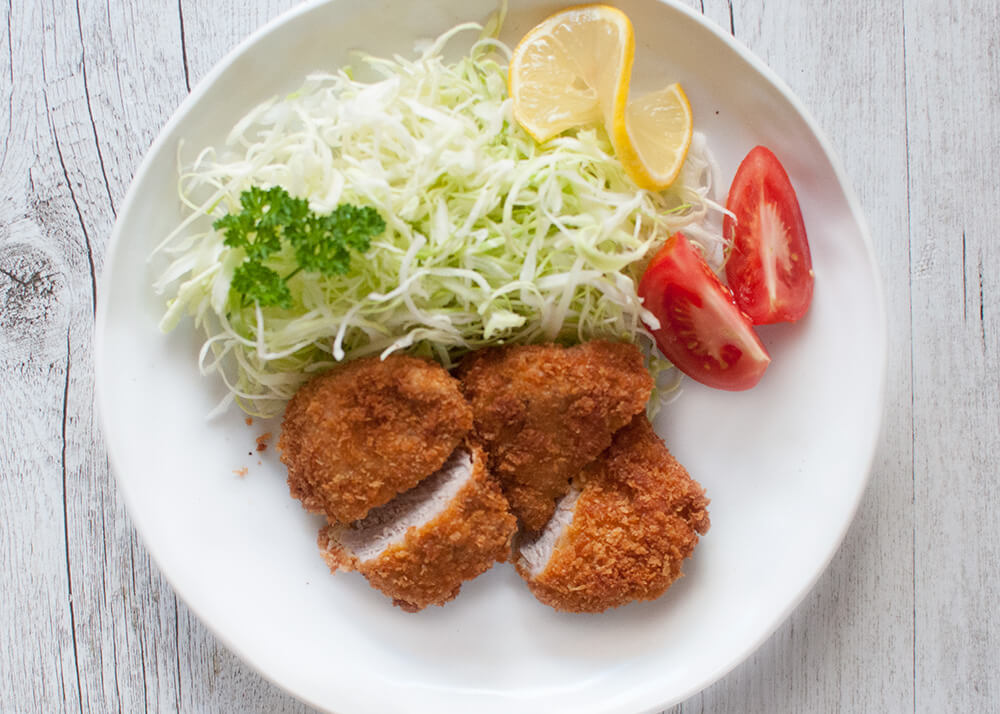
Great tip for the Tonkatsu, being British I always have Worcester Sauce in the cupboard. Also love the tip on leaving the fat on the loin, really looking forward to giving this a try.
Hi Shaun, I am sure you do have Worcestershire sauce. Every Brits must have it! Good luck with cooking Tonkatsu. Let me know what you think.
Hello, yumiko
Where I live meat cuts usually have names different from those of other countries, so it is not clear to me: pork tenderloin is the same as pork chop?
Another question, is that the worcesteshire sauce tends to be in little sour and spicy, the tokantsu sauce is too? (My family does not like spicy food)
By the way I appreciate your recipes, because they are not as “westernized” as others that can be found on the internet
Hi Ruth, I know, the names of ingredients are quite confusing.
Here is the link explaining various cuts of pork. Would it help?
Tonkatsu sauce is much sweeter fruitier and not spicy. I think your family would enjoy it.
And thanks for your kind words.
Delicious! Quick n easy
Thank you!
Hello Yumiko. Your recipes are wonderful. After experiencing a cooking rut, your guidance has led me to new and delicious menu ideas. My family and dinner guests have heartily enjoyed them all. Many thanks. Kathleen
You are most welcome, Kathleen. I’m glad that your family and friends enjoyed the meal.
This is my favorite Tonkatsu sauce. The Heinz 57 rocks it
2/3C soy sauce
1/2C Heinz 57
1 apple, or Asian pear chopped
1 small onion, chopped
1 can of 8 oz canned crushed pineapple and their juice
2T Worcestershire sauce
6T brown sugar
4T corn syrup
* combine all the ingredients in a sauce pan over medium heat. Boil and simmer over low heat for about 20 minutes until it gets thickened and syrupy. Strain the sauce in the strainer pressing with spoon to get all the juice. Discard the filling and keep the sauce in the fridge until ready to use. Makes about 1/2C
Hi Jack, it sounds like a real deal tonkatsu sauce! I will try that. Thank for sharing the recipe.
Oh, thank you for this postiong. I love Tonkatsu, but mine is never as good as what I get when dining in a good Japanese restaurant. After reading your great post, I now know my mistake, preparing the meat. I never put much thought into that part. This one going to be made very soon.
Hi Ron, good luck with the next tonkatsu making. Good preparation could make such a difference in final product. It’s not just cooking. I used to do dress making (just as hobby) and I believe that cutting the fabric precisely makes sewing so much easier. The same concept, I thought.
You know I LOVE this mum! I was waiting for this recipe!!
I am glad that I finally posted this so that you won’t hustle me any more.
Looks so juicy and delish! and I agree the best sauce is Bulldog brand. It is my favourite tonkatsu sauce 😀
Yes! Bulldog sauce has been around for long time so it must be good.
You got me craving for a good Tonkatsu — It is one of my favorite Japanese food! thank you for sharing lots of tips! Hope you’ll feature more Japanese side dishes too. 🙂
Hi Trish. I will try side dishes when I can.
Thank you for the very clear instructions. I feel more confident to try making this.
Thank you. Good luck with Tonkatsu!